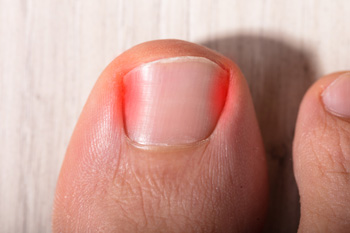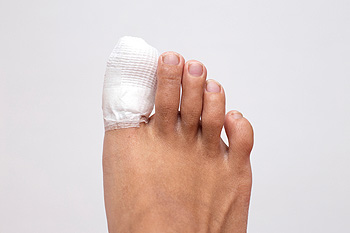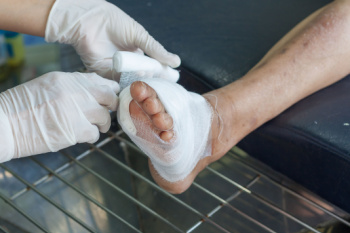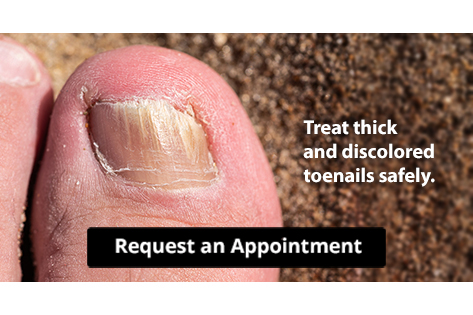Connect With Us
Blog
Items filtered by date: August 2024
Managing Athlete’s Foot

Athlete's foot is a fungal infection that affects the skin on the feet, often leading to itching, redness, and cracking. The fungi typically thrive in warm, damp environments, making communal showers, locker rooms, and swimming pools ideal breeding grounds. Athlete’s foot can spread easily through direct contact with contaminated surfaces or directly from person to person. While cases can sometimes clear up with mild treatments, persistent or severe cases may require professional care. A podiatrist can provide a more accurate diagnosis and recommend treatment options to effectively manage the infection. This may include prescription antifungal medications, guidance on proper foot hygiene, and strategies to prevent recurrence. If you have a troublesome case of athlete's foot, it is suggested that you schedule an appointment with a podiatrist for advanced treatment options.
Athlete’s foot is an inconvenient condition that can be easily reduced with the proper treatment. If you have any concerns about your feet and ankles, contact one of our doctors from New Jersey and New York. Our doctors will treat your foot and ankle needs.
Athlete’s Foot: The Sole Story
Athlete's foot, also known as tinea pedis, can be an extremely contagious foot infection. It is commonly contracted in public changing areas and bathrooms, dormitory style living quarters, around locker rooms and public swimming pools, or anywhere your feet often come into contact with other people.
Solutions to Combat Athlete’s Foot
- Hydrate your feet by using lotion
- Exfoliate
- Buff off nails
- Use of anti-fungal products
- Examine your feet and visit your doctor if any suspicious blisters or cuts develop
Athlete’s foot can cause many irritating symptoms such as dry and flaking skin, itching, and redness. Some more severe symptoms can include bleeding and cracked skin, intense itching and burning, and even pain when walking. In the worst cases, Athlete’s foot can cause blistering as well. Speak to your podiatrist for a better understanding of the different causes of Athlete’s foot, as well as help in determining which treatment options are best for you.
If you have any questions please feel free to contact our offices located in Little Silver, NJ and New York, NY . We offer the newest diagnostic and treatment technologies for all your foot and ankle needs.
Identifying the Symptoms and Causes of an Ingrown Toenail

An ingrown toenail occurs when the edge of the nail grows into the surrounding skin, leading to discomfort and potential infection. Symptoms typically include redness, swelling, and pain surrounding the affected toenail. In more severe cases, there might be noticeable pus or a throbbing sensation. The condition often arises from factors such as wearing improperly fitting shoes, which place undue pressure on the toes, or incorrect nail trimming techniques, which can cause the nail to grow inward. Other contributing factors include genetic predisposition and trauma to the toe. Proper nail care, including trimming nails straight across and wearing well-fitted shoes, is essential in preventing ingrown toenails. An ingrown toenail can cause consistent pain and discomfort. If this applies to you, it is strongly suggested that you consult a podiatrist who can determine what the best course of treatment is for you, which may include minor surgery for removal.
Ingrown toenails can become painful if they are not treated properly. For more information about ingrown toenails, contact one of our doctors of New Jersey and New York. Our doctors can provide the care you need to keep you pain-free and on your feet.
Ingrown Toenails
Ingrown toenails occur when a toenail grows sideways into the bed of the nail, causing pain, swelling, and possibly infection.
Causes
- Bacterial infections
- Improper nail cutting such as cutting it too short or not straight across
- Trauma to the toe, such as stubbing, which causes the nail to grow back irregularly
- Ill-fitting shoes that bunch the toes too close together
- Genetic predisposition
Prevention
Because ingrown toenails are not something found outside of shoe-wearing cultures, going barefoot as often as possible will decrease the likeliness of developing ingrown toenails. Wearing proper fitting shoes and using proper cutting techniques will also help decrease your risk of developing ingrown toenails.
Treatment
Ingrown toenails are a very treatable foot condition. In minor cases, soaking the affected area in salt or antibacterial soaps will not only help with the ingrown nail itself, but also help prevent any infections from occurring. In more severe cases, surgery is an option. In either case, speaking to your podiatrist about this condition will help you get a better understanding of specific treatment options that are right for you.
If you have any questions please feel free to contact our offices located in Little Silver, NJ and New York, NY . We offer the newest diagnostic and treatment technologies for all your foot and ankle needs.
Stop Your Toenail Fungus
Is It a Broken Toe?

A broken toe, often caused by stubbing it against furniture, dropping something heavy on it, or trauma during sports, can be quite painful. Symptoms can include redness, swelling, bruising, and difficulty in walking. Sometimes, you might even hear a crack at the time of injury or notice the toe looking out of place. For a mild fracture, treatments such as resting, taking pain relief medication, and wearing comfortable shoes or orthotics can help. Taping the injured toe to the one next to it is another way to manage the pain and aid healing. However, if pain persists after a few days, swelling doe not subside, or if you have trouble walking after six weeks, it is suggested that you schedule an appointment with a podiatrist to get a precise diagnosis and treatment options.
A broken toe can be very painful and lead to complications if not properly fixed. If you have any concerns about your feet, contact one of our doctors from New Jersey and New York. Our doctors will treat your foot and ankle needs.
What to Know About a Broken Toe
Although most people try to avoid foot trauma such as banging, stubbing, or dropping heavy objects on their feet, the unfortunate fact is that it is a common occurrence. Given the fact that toes are positioned in front of the feet, they typically sustain the brunt of such trauma. When trauma occurs to a toe, the result can be a painful break (fracture).
Symptoms of a Broken Toe
- Throbbing pain
- Swelling
- Bruising on the skin and toenail
- The inability to move the toe
- Toe appears crooked or disfigured
- Tingling or numbness in the toe
Generally, it is best to stay off of the injured toe with the affected foot elevated.
Severe toe fractures may be treated with a splint, cast, and in some cases, minor surgery. Due to its position and the pressure it endures with daily activity, future complications can occur if the big toe is not properly treated.
If you have any questions please feel free to contact our offices located in Little Silver, NJ and New York, NY . We offer the newest diagnostic and treatment technologies for all your foot and ankle needs.
Caring for Diabetic Feet
 For diabetic patients, foot care is essential due to the increased risk of complications like infections and ulcers. Start by maintaining good foot hygiene. Wash feet daily with lukewarm water and mild soap, and dry thoroughly, especially between the toes. Moisturize your feet to prevent dryness and cracking, but avoid applying lotion between the toes to reduce the risk of fungal infections. Regularly inspect your feet for cuts, blisters, redness, or swelling, and use a mirror or ask for help if needed. Trim nails carefully, straight across, and file the edges to avoid ingrown toenails. Wear well-fitting, comfortable shoes and clean, dry socks to prevent blisters and sores. Avoid walking barefoot, even at home. If you are a diabetic patient, it is suggested that you schedule regular visits to a podiatrist for professional care and advice. They can manage any developing issues early and provide guidance on proper footwear and orthotics.
For diabetic patients, foot care is essential due to the increased risk of complications like infections and ulcers. Start by maintaining good foot hygiene. Wash feet daily with lukewarm water and mild soap, and dry thoroughly, especially between the toes. Moisturize your feet to prevent dryness and cracking, but avoid applying lotion between the toes to reduce the risk of fungal infections. Regularly inspect your feet for cuts, blisters, redness, or swelling, and use a mirror or ask for help if needed. Trim nails carefully, straight across, and file the edges to avoid ingrown toenails. Wear well-fitting, comfortable shoes and clean, dry socks to prevent blisters and sores. Avoid walking barefoot, even at home. If you are a diabetic patient, it is suggested that you schedule regular visits to a podiatrist for professional care and advice. They can manage any developing issues early and provide guidance on proper footwear and orthotics.
Diabetic foot care is important in preventing foot ailments such as ulcers. If you are suffering from diabetes or have any other concerns about your feet, contact one of our doctors from New Jersey and New York. Our doctors can provide the care you need to keep you pain-free and on your feet.
Diabetic Foot Care
Diabetes affects millions of people every year. The condition can damage blood vessels in many parts of the body, especially the feet. Because of this, taking care of your feet is essential if you have diabetes, and having a podiatrist help monitor your foot health is highly recommended.
The Importance of Caring for Your Feet
- Routinely inspect your feet for bruises or sores.
- Wear socks that fit your feet comfortably.
- Wear comfortable shoes that provide adequate support.
Patients with diabetes should have their doctor monitor their blood levels, as blood sugar levels play such a huge role in diabetic care. Monitoring these levels on a regular basis is highly advised.
It is always best to inform your healthcare professional of any concerns you may have regarding your feet, especially for diabetic patients. Early treatment and routine foot examinations are keys to maintaining proper health, especially because severe complications can arise if proper treatment is not applied.
If you have any questions please feel free to contact our offices located in Little Silver, NJ and New York, NY . We offer the newest diagnostic and treatment technologies for all your foot and ankle needs.

